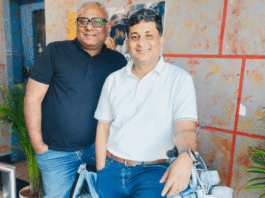It is difficult to believe that a single small business can radically alter our shopping habits; Flipkart, though, has done precisely that. In 2007, e-commerce was still seen as a separate business category, and most Indians shopped offline. However, the internet was taking over the world, and Steve Jobs had just released the world’s first iPhone, which was about to revolutionize the smartphone market in the coming years.
Sachin and Binny Bansal, two Indian software engineers from IIT, noticed the shifting dynamics of technology and recognized the potential of E-commerce. While there were only 50 million internet users in India, they understood that with the introduction of smartphones, it would only be a matter of time before more Indians were online. So they aimed to take advantage of this opportunity to create an online shopping platform that would elevate India’s buying experience.
India now has over 620 million internet users, with considerable growth in people purchasing online. What began as a two-person ambition to create India’s most trusted online shopping platform has grown into Flipkart, the country’s largest e-commerce site, with 150 million products, over 80 categories and over 200 million customers.
In 2007, after quitting Amazon, both Sachin and Binny Bansal pooled 0.4 million together and founded Flipkart. They chose to offer books on their platform because they found it easier to list, ship, and find vendors than other categories such as electronics or apparel, which might have costed them a lot of money.
People still didn’t grasp the internet, and doing business online wasn’t very common; therefore, most vendors were initially skeptical and distrustful of their business plan. However, the duo persisted and established their website in October of 2007 after persuading vendors. By the end of October, they had received their first order from Telangana. However, their delight over their first order quickly turned into a matter of concern when their vendors informed them that the book was out of stock. After frantically searching Bangalore for the book, the duo finally got their hands on it and delivered their first order successfully. With that, Flipkart was now officially open for business.
Within six months, the Bangaluru-based company was profitable, and by the end of 2009, Flipkart had sold 40 million worth of books. Flipkart received a $1 million investment from Accel Partners, a well-known investment firm, in 2009. The company had over 150 workers and three offices across India by the end of 2009.
Tiger Global joined as a new partnership in 2010, with the first investment of US$ 10 million.
Flipkart was able to take the next step now that it had established itself as India’s preferred marketplace for book enthusiasts. Flipkart was able to enter the electronics industry due to the new partners and increased investment. As a result, they began selling mobile phones in 2010.
Flipkart had still established enough influence among its clients to earn that level of trust. The founders were pushed to think in new ways as a result of this challenge. And that they were prepared to come up with a brilliant solution to implement Cash on Delivery. Flipkart was one of the first E-commerce companies to offer customers the option of paying with cash on delivery. The founders were utterly focused on establishing trust among Indian consumers. They doubled down on their goal by implementing a no-questions-asked return policy, followed by a replacement policy. They were willing to put client happiness ahead of growth.
Sachin served as the CEO of Flipkart for nine years. Binny Bansal took over the position of CEO in 2016, with Sachin becoming executive chairman. And in 2017, Kalyan Krishnamurthy, a former executive of Flipkart investor Tiger Global, was named CEO of Flipkart.
In 2014, Flipkart paid $300 million for online garment store Myntra, and in 2016, it paid $70 million for another fashion retailer, Jabong. In 2016, it acquired the payment startup PhonePe. eBay agreed to invest $500 million in Flipkart in exchange for an equity share and sell its eBay.in the company to Flipkart in 2017. Walmart purchased a 77 per cent share in Flipkart for $ 16 billion in 2018.
In 2016, Flipkart surpassed the 100 million customer mark, and Sachin and Binny were named to TIME magazine’s 100 most influential people list.
Seattle poses the greatest challenge to Flipkart with its e-commerce major, Amazon. Over $6.5 billion has been invested in the South Asian market by the American e-commerce company. Despite heated competition from archrival Amazon, the corporation has remained successful despite numerous fundamental leadership changes in recent years. Walmart’s $16 billion investment has proven to be a watershed moment, even if it resulted in co-founder Sachin Bansal’s departure. The Big Billion Days are outperforming their competition in terms of revenue.
Looking at India’s indigenous e-commerce company Flipkart’s journey, it’s evident that it never lost faith in its investors and customers. A success story like this doesn’t come too often. Flipkart has a lot of potential for continued growth and will be remembered for many years to come. Moreover, their success is a source of encouragement for young Indian entrepreneurs.



